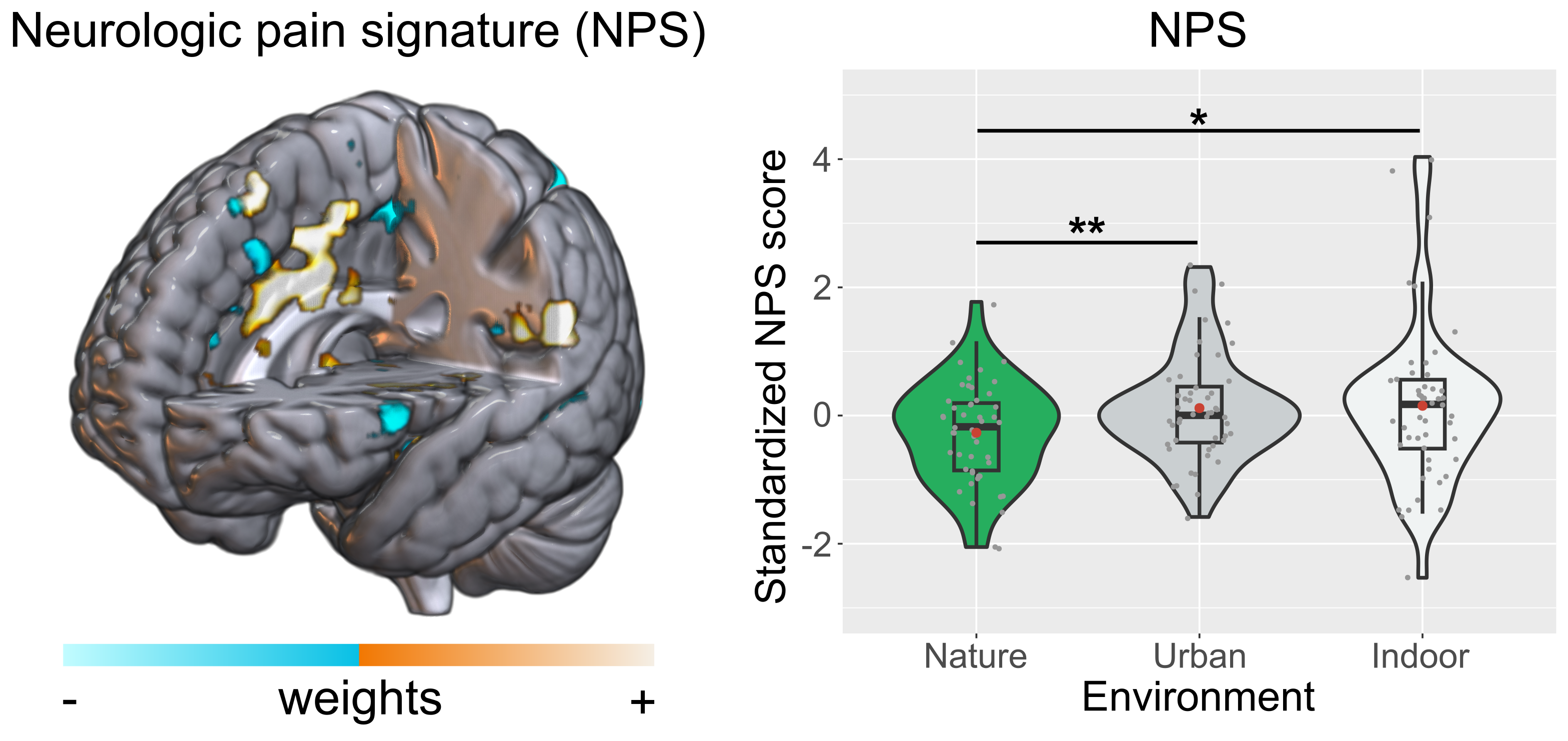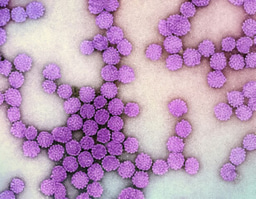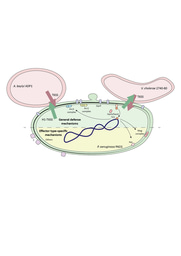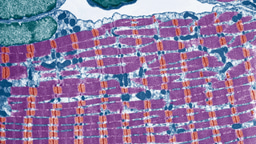How nature can reduce pain in the brain
Published in Neuroscience, Pharmacy & Pharmacology, and Behavioural Sciences & Psychology

The benefits of nature contact - whether taking a walk in the park or simply listening to birdsong – are well-documented for both physical and mental well-being. But can nature also shape how humans perceive pain? While systematically reviewing the existing literature, we noticed a recurring pattern: people consistently rate pain as less intense or unpleasant when exposed to nature. Yet, the available evidence left us with unanswered questions and reasons for skepticism. First, many of the published studies we knew compared nature to conditions that didn’t clearly isolate its specific role - often contrasting it against no stimulation at all or with unpleasant, unappealing alternatives. Second, these studies offered limited insight into why nature reduces pain. As researchers in a lab specializing in social, cognitive, and affective neuroscience (https://scan-psy.univie.ac.at/), we set out to answer these questions using a controlled experimental design and functional magnetic resonance imaging (fMRI). Would nature still have an effect when compared to well-matched control conditions? And if so, what happens on the level of the brain that would explain this pain relief?
A major challenge in this endeavor was bringing nature into the MRI scanner. Previous studies in environmental neuroscience, which investigated nature’s effects on cognition and emotion, often had participants take short walks in natural settings before measuring their brain activity in the scanner (Bratman et al., 2015; Sudimac et al., 2022). However, this approach couldn’t capture the immediate neural response to acute pain, which was central to our research. Thus, we turned to virtual nature as a solution. On the one hand, this allowed us to simultaneously expose participants to nature and acute pain, while measuring both their subjective and neural responses. On the other hand, it provided the added benefit of allowing us to carefully control for key aspects of our experimental manipulation. This was crucial, to ensure that changes in pain were not merely due to increased pain caused by potential negative aspects of the control conditions. Therefore, by using virtual stimuli we aimed to design largely matched environments that would enable us to examine whether nature would still reduce pain compared to these relatively matched settings. On an additional note, based on previous studies by some of our team members (Smalley et al., 2023), we knew that even virtual environments could evoke powerful reactions in participants. To create an immersive experience in the scanner, we collaborated with a graphic designer to develop customized virtual scenes. We started with a natural setting, incorporating key elements from restorative environment research, such as reflective water surfaces, open spaces, or foliage from trees and bushes. We also added ephemeral features, including transitions between times of day, which are essential to nature experiences. Once the nature scene was designed, we created a matched urban environment by adding urban elements. This urban setting contained many elements of the nature scene, maintaining similar low-level features such as lighting, movement, or sound intensity. However, contrasting nature only with this urban environment would not be enough to determine whether nature truly reduces pain. What if the urban setting simply increased pain? Or what if both nature and urban scenes had pain-reducing effects compared to a neutral control, with nature being merely more effective? To address this, we introduced a third condition: an indoor environment (Figure 1). This added an extra layer of control, allowing us to better isolate the effects of nature. Participants were then exposed to each of the environments while simultaneously experiencing acute pain in the MRI scanner.

But why did we invite participants into the scanner in the first place? Pain is a multifaceted phenomenon, involving various aspects: from the early sensory signals our brain receives, which inform us of the pain’s location and intensity, to the complex emotional and cognitive reactions we have toward this information. All these aspects contribute to the subjective experience of pain, but disentangling their roles through self-report is challenging. By using established as well as more recently developed machine-learning-based neuroscience approaches, we expected to provide more definite answers and pinpoint the specific aspects of pain that are altered - as well as the neural mechanisms involved. For example, recent advancements in neuroscience have successfully been used to explore what happens in the brain when pain is reduced through interventions like placebo treatments (Botvinik-Nezer et al., 2024) or mindfulness-based meditation (Wielgosz et al., 2022). However, similar evidence on nature’s analgesic effect was missing. While we expected that neural responses to pain would generally be reduced when participants were exposed to nature, we didn’t know which specific processes would be altered.
Did nature’s analgesic effect withstand the test of more rigorous control conditions? Our results suggest yes. First, in line with prior research, we also found a consistent pattern of reduced self-reported pain, even when comparing nature to a matched urban environment and an additional indoor setting. Of central importance, we also observed reduced neural responses to pain in the virtual nature condition. Notably, this suggests that the effect wasn’t simply due to participants’ tendency to report pain in a way that matched their beliefs and expectations. Instead, the brain’s response to pain itself was altered - most crucially in regions and patterns associated with sensory rather than emotional or motivational aspects (Figure 2). This finding is particularly intriguing, because it contrasts with placebo research, which shows that when people take what they believe is an effective painkiller - but is actually a placebo - it mainly changes emotional and higher-level cognitive aspects of pain rather than its sensory processing. This further supports our interpretation that the effect is not simply due to participant expectations, reporting biases, or downstream effects of pain tapping more into motivational or emotional processes. In other words, our study suggests that nature influences the “root causes” of pain, rather than just how the brain processes a sensory pain signal once it has passed on to more complex and higher-order processing.

By leveraging neuroscientific approaches alongside a controlled experimental design, we took an important first step in reducing uncertainty and strengthening the evidence for nature’s analgesic effects. We hope that future research will continue to build on this foundation, as many unanswered questions remain. Can similar beneficial effects be found in patients suffering from chronic pain? Might nature influence other aspects of the pain processing hierarchy? Which types of nature are most effective, and how can these be integrated into medical contexts and pain management strategies? We are one step closer to understanding whether and why nature could be a useful complementary approach to pain treatment, but much work remains to be done.
References:
Bratman, G. N., Hamilton, J. P., Hahn, K. S., Daily, G. C., & Gross, J. J. (2015). Nature experience reduces rumination and subgenual prefrontal cortex activation. Proceedings of the national academy of sciences, 112(28), 8567-8572.
Sudimac, S., Sale, V., & Kühn, S. (2022). How nature nurtures: Amygdala activity decreases as the result of a one-hour walk in nature. Molecular psychiatry, 27(11), 4446-4452.
Smalley, A. J., & White, M. P. (2023). Beyond blue-sky thinking: Diurnal patterns and ephemeral meteorological phenomena impact appraisals of beauty, awe, and value in urban and natural landscapes. Journal of Environmental Psychology, 86, 101955.
Botvinik-Nezer, R., Petre, B., Ceko, M., Lindquist, M. A., Friedman, N. P., & Wager, T. D. (2024). Placebo treatment affects brain systems related to affective and cognitive processes, but not nociceptive pain. Nature communications, 15(1), 6017.
Wielgosz, J., Kral, T. R., Perlman, D. M., Mumford, J. A., Wager, T. D., Lutz, A., & Davidson, R. J. (2022). Neural signatures of pain modulation in short-term and long-term mindfulness training: a randomized active-control trial. American Journal of Psychiatry, 179(10), 758-767.
Follow the Topic
-
Nature Communications

An open access, multidisciplinary journal dedicated to publishing high-quality research in all areas of the biological, health, physical, chemical and Earth sciences.
Related Collections
With Collections, you can get published faster and increase your visibility.
Women's Health
Publishing Model: Hybrid
Deadline: Ongoing
Advances in neurodegenerative diseases
Publishing Model: Hybrid
Deadline: Dec 24, 2025






Please sign in or register for FREE
If you are a registered user on Research Communities by Springer Nature, please sign in